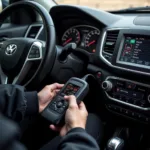A car that won’t start and shows no spark indicates a problem with its ignition system. This issue can stem from various culprits, from a faulty battery to a malfunctioning crankshaft position sensor. This comprehensive guide will delve into the common causes of a no-spark situation, guiding you through the diagnostic process and offering potential solutions.
Understanding the Basics: How Car Ignition Systems Work
Before diving into diagnostics, it’s crucial to grasp the basics of a car’s ignition system. The system is responsible for generating the spark that ignites the air-fuel mixture in the engine cylinders, propelling your vehicle forward. Here’s a simplified breakdown:
- Battery: The battery provides the initial electrical power to the ignition system.
- Ignition Switch: Turning the key activates the ignition switch, allowing the flow of electricity.
- Ignition Coil: This component transforms the battery’s low voltage into the high voltage needed to create a spark.
- Crankshaft Position Sensor: This sensor monitors the position of the crankshaft, sending signals to the engine control unit (ECU) to determine the timing of the spark.
- Distributor (in older vehicles): The distributor receives the high-voltage current from the ignition coil and distributes it to the correct spark plug at the right time.
- Spark Plugs: These components are responsible for delivering the spark to ignite the fuel.
Common Causes of “Car Won’t Start Diagnostics No Spark”
When your car doesn’t start and a spark test reveals no spark, several potential culprits could be at play:
1. Dead or Weak Battery
A dead or dying battery is often the primary suspect in a no-start situation, even if you think your battery is fine. A weak battery might have enough power to run accessories but lack the juice to power the starter motor and ignition system.
2. Faulty Ignition Coil
The ignition coil is the heart of the spark generation process. If it malfunctions, the high voltage needed for the spark won’t be produced.
3. Defective Crankshaft Position Sensor
The crankshaft position sensor plays a critical role in spark timing. A faulty sensor can send incorrect signals to the ECU, leading to a no-spark condition.
4. Worn-out Spark Plugs
Over time, spark plugs can wear down, making it difficult for them to generate a strong spark.
5. Malfunctioning Ignition Switch
While less common, a faulty ignition switch can disrupt the flow of electricity to the ignition system, preventing spark generation.
6. Problems with Wiring and Connections
Loose or corroded wiring and connections within the ignition system can interrupt the electrical flow, leading to a no-spark scenario.
Diagnosing the “No Spark” Issue
If your car won’t start and you suspect a no-spark problem, here’s a step-by-step diagnostic approach:
- Check the Battery: Begin with the basics. Inspect the battery terminals for corrosion. Clean them if necessary. If the battery is old or you suspect it’s weak, try jump-starting your car.
- Inspect the Spark Plugs: Remove a spark plug and visually examine it. Look for signs of wear, such as excessive deposits or a worn electrode. If the spark plug looks worn, replace all spark plugs.
- Test for Spark: With a spark plug removed and connected to its wire, ground the metal body of the spark plug against the engine block. Have a helper crank the engine while you observe the spark plug gap. If there’s no spark, continue troubleshooting.
- Inspect Ignition Coil and Wiring: Visually examine the ignition coil for signs of damage or loose connections. Check the wiring harness connected to the coil for any fraying or damage.
- Test the Crankshaft Position Sensor: Testing this sensor typically requires a multimeter and some technical knowledge. Consult your car’s repair manual or seek professional help if you’re not comfortable performing this test.
When to Seek Professional Help
While some no-spark issues can be diagnosed and resolved with basic tools and some mechanical know-how, others require the expertise of a qualified mechanic. If your diagnostic efforts don’t pinpoint the problem or you’re not comfortable working on your car’s electrical system, it’s best to seek professional help.
Conclusion
A “car won’t start diagnostics no spark” situation can be frustrating, but by understanding the common causes and following a systematic diagnostic approach, you can pinpoint the problem and get your car back on the road. Remember, while this guide provides general information, every car is different, and professional diagnosis might be necessary for a definitive solution.


